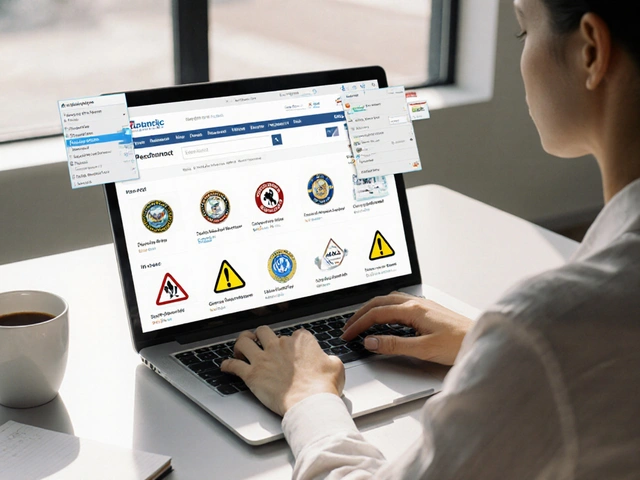
If you’ve ever been prescribed Periactin for allergies, itching, or even appetite loss, you’ve probably wondered how it stacks up against the more common antihistamines you see on pharmacy shelves. The short answer? It’s a powerful but niche option that shines in specific scenarios, while other drugs win on ease of use or fewer side effects. This guide walks through how Periactin works, what makes it unique, and how it compares to popular alternatives like Diphenhydramine, Cetirizine, Loratadine, Fexofenadine, and Doxepin. By the end you’ll know exactly when Periactin is the right pick and when another antihistamine will serve you better.
What is Periactin (Cyproheptadine)?
Periactin (Cyproheptadine) is a first‑generation H1‑receptor antagonist that also blocks serotonin receptors. It was originally introduced in the 1960s to treat allergic reactions, but its appetite‑stimulating and anti‑migraine properties have kept it in use for niche indications.
Because it crosses the blood‑brain barrier, Periactin often causes drowsiness, but that very sedative effect can be therapeutic for patients with insomnia driven by allergic symptoms. Its serotonin‑blocking action also makes it useful for certain serotonin‑related conditions, such as serotonin syndrome or certain types of chronic headaches.
How Periactin Works - The Pharmacology Bite
- H1 receptor antagonism: Stops histamine from binding to H1 receptors, reducing itching, swelling, and bronchoconstriction.
- Serotonin (5‑HT2) antagonism: Dampens serotonin‑driven pathways, which can curb excessive appetite loss and reduce migraine frequency.
- Anticholinergic activity: Contributes to the classic “wet‑dog” side effects (dry mouth, blurred vision) seen with many first‑generation antihistamines.
Typical adult dosing for allergy relief is 4 mg up to three times daily, while appetite stimulation often starts at 8 mg once daily. The drug’s half‑life is roughly 8 hours, so steady‑state levels are achieved after a few days of consistent dosing.
Key Benefits of Periactin
- Strong anti‑allergic action: It tackles both histamine‑mediated and serotonin‑mediated symptoms, offering broader coverage than many second‑generation antihistamines.
- Appetite stimulation: Especially valuable for children with failure to thrive or adults experiencing cachexia due to chronic disease.
- Sedative aid: The drowsiness can double as a sleep aid when allergic rhinitis keeps patients up at night.
Side‑Effect Profile - What to Watch For
Periactin’s potency comes with a trade‑off. The most common adverse events include:
- Moderate to severe drowsiness (up to 40 % of patients)
- Dry mouth, constipation, and blurred vision (anticholinergic effects)
- Weight gain - a plus for some, a concern for others
- Rarely, tachycardia or urinary retention in older adults
Because it can cross the placenta, Periactin is classified as Pregnancy Category C in the US, meaning risks must be weighed carefully.

Popular Alternatives - Quick Overview
Below is a snapshot of the most frequently prescribed antihistamines that sit in the same therapeutic space.
Diphenhydramine - a classic first‑generation antihistamine best known for its overnight sleep‑aid reputation.
Cetirizine - a second‑generation drug that offers strong allergy relief with less sedation.
Loratadine - another second‑generation antihistamine, praised for its minimal drowsiness.
Fexofenadine - a non‑sedating second‑generation option, often used for seasonal allergies.
Doxepin - a tricyclic antidepressant that doubles as a potent H1 blocker, useful for chronic urticaria.
Side‑Effect Snapshots of the Alternatives
| Drug | Typical Sedation | Anticholinergic Load | Pregnancy Category |
|---|---|---|---|
| Diphenhydramine | High | Moderate | B |
| Cetirizine | Low‑moderate | Low | B |
| Loratadine | Low | Low | B |
| Fexofenadine | None | None | B |
| Doxepin | Variable (dose‑dependent) | High | C |
Comparison Table - Periactin vs the Rest
| Drug | Class | Typical Dose (adult) | Sedation | Appetite Effect | Pregnancy Safety |
|---|---|---|---|---|---|
| Periactin (Cyproheptadine) | First‑gen H1 & 5‑HT2 antagonist | 4 mg 2-3×/day (allergy) / 8 mg daily (appetite) | Moderate-high | Stimulates | Category C |
| Diphenhydramine | First‑gen H1 antagonist | 25‑50 mg q6‑8h | High | Neutral | Category B |
| Cetirizine | Second‑gen H1 antagonist | 10 mg daily | Low‑moderate | Neutral | Category B |
| Loratadine | Second‑gen H1 antagonist | 10 mg daily | Low | Neutral | Category B |
| Fexofenadine | Second‑gen H1 antagonist | 180 mg BID or 120 mg daily | None | Neutral | Category B |
| Doxepin | Tricyclic antidepressant, potent H1 blocker | 3‑6 mg nightly (urticaria) | Variable | Neutral | Category C |

When Periactin Beats the Competition
Put Periactin on the front‑line list if you’re dealing with any of these situations:
- Appetite loss: Cancer patients, children with failure‑to‑thrive, or anyone on a strict diet who needs a safe stimulant.
- Combined allergic and migraine symptoms: The serotonin blockade helps lessen headache frequency while the H1 antagonism controls itch and swelling.
- Severe itching (pruritus) that hasn’t responded to second‑generation drugs: Periactin’s higher receptor affinity can make the difference.
- Need for a sedating antihistamine at night: Instead of adding a separate sleep aid, Periactin covers both.
If your main goal is daytime allergy relief with minimal drowsiness, a second‑generation agent like Cetirizine or Loratadine usually wins. For patients who can’t tolerate any sedation-like truck drivers, pilots, or students-Fexofenadine is the safest bet.
Quick Decision Checklist
- Do you need appetite stimulation? Yes → Periactin.
- Is daytime drowsiness acceptable? Yes → Periactin or Diphenhydramine.
- Are you pregnant or planning pregnancy? Prefer second‑gen (Cetirizine, Loratadine, Fexofenadine).
- Do you have a history of urinary retention or glaucoma? Avoid first‑gen agents (Periactin, Diphenhydramine).
- Is cost a major factor? Most second‑gen antihistamines are cheaper and over‑the‑counter.
Practical Tips for Using Periactin Safely
- Start low, go slow: Begin with 4 mg once daily; increase only if needed and tolerated.
- Take with food: Reduces gastrointestinal upset and helps with appetite‑stimulating effect.
- Avoid alcohol and other CNS depressants: The combined sedation can impair coordination.
- Monitor weight: Record any rapid gain, especially in children.
- Review with your clinician before pregnancy: Discuss risk‑benefit if you’re planning a family.
Frequently Asked Questions
Can Periactin be used for childhood allergies?
Yes, but only under a pediatrician’s guidance. The usual dose for kids 6‑12 years is 2 mg twice daily, and the doctor will watch for excessive drowsiness.
Is Periactin effective for chronic urticaria?
It can help, especially when antihistamine‑resistant hives are linked to serotonin pathways. Many specialists start with 4 mg at bedtime and adjust based on symptom control.
How does Periactin differ from Diphenhydramine?
Both are first‑generation H1 blockers, but Periactin also blocks 5‑HT2 serotonin receptors, giving it appetite‑stimulating and migraine‑relief benefits that Diphenhydramine lacks.
Can I take Periactin with other antihistamines?
Generally not recommended. Combining two H1 antagonists can amplify sedation and anticholinergic side effects. If a second agent is needed, a doctor might suggest a non‑sedating option like Loratadine at a low dose.
What should I do if I miss a dose?
Take the missed dose as soon as you remember, unless it’s almost time for the next one. In that case, skip the missed dose and continue with the regular schedule - don’t double up.
Bottom line: Periactin isn’t the first drug most doctors reach for, but when you need a dual‑action antihistamine that also boosts appetite or tackles serotonin‑linked headaches, it can be a game‑changer. Keep the checklist handy, discuss with your clinician, and you’ll know whether Periactin or one of its smoother‑sailing cousins is the smart pick for you.
Write a comment
Your email address will not be published.





10 Comments
Wow, diving into the world of Periactin feels like stepping onto a dramatic stage where every symptom gets its own spotlight! This drug isn’t just another antihistamine-it’s a multitasking hero that tames itch, sparks appetite, and even lulls you into sweet sleep. Imagine a patient battling relentless pruritus and a stubborn loss of appetite; Periactin swoops in, blocking both histamine and serotonin pathways. The drowsiness? Think of it as a sidekick that helps restless nights finally calm down. Of course, you’ll need to watch for that classic “wet‑dog” dryness and weight changes. So, if you’re ready for a bold, all‑in‑one option, Periactin might just be your star performer.
Periactin’s dual H1 and 5‑HT2 antagonism distinguishes it from standard second‑generation agents, making it suitable for appetite stimulation and migraine adjunct therapy.
When we assess antihistamines, we must look beyond simple histamine blockade and consider the broader neurochemical landscape. Periactin’s serotonin receptor antagonism adds a layer of complexity that many clinicians overlook. This dual action can attenuate serotonin‑driven nausea and even reduce migraine frequency, providing a therapeutic edge in refractory cases. However, the price of crossing the blood‑brain barrier is heightened central sedation, which may be undesirable for individuals requiring daytime alertness. The drug’s half‑life of roughly eight hours demands careful titration to maintain steady plasma levels without overshooting. In populations with compromised hepatic function, dose adjustments become imperative to avoid accumulation. Comparative studies suggest that while second‑generation antihistamines excel in low‑sedation profiles, they lack the appetite‑stimulating benefit that Periactin uniquely offers. Therefore, prescribing decisions should balance the need for sedation, appetite effects, and the patient’s comorbidities. From a pharmacoeconomic perspective, Periactin may be cost‑effective for niche indications despite its less favorable side‑effect profile. Ultimately, the clinician’s judgment must reconcile these trade‑offs with the patient’s quality‑of‑life goals.
Look, Periactin is not a magic pill; it’s a heavy‑handed first‑gen antihistamine that will knock you out if you’re not careful. The dry mouth and blurry vision are the price you pay for that “everything‑in‑one” claim. If you just need daytime relief, reach for a modern second‑generation drug instead. Don’t be fooled by hype-this stuff is old school and brings baggage.
Some people think that every medication on the market is safe and that the government hides nothing but the truth yet the reality is that Periactin sits in a gray zone where its benefits are often overstated and its risks are downplayed by pharmaceutical PR machines it blocks histamine and serotonin pathways which sounds impressive but also means it penetrates the brain causing sedation that can impair judgment especially for those operating heavy machinery or driving long distances the anticholinergic side effects like dry mouth blurred vision and constipation are not just minor annoyances they can lead to serious complications in elderly patients with glaucoma or urinary retention doctors should be wary of prescribing it to pregnant women given its Category C status the lack of robust long‑term studies leaves a gap in our knowledge and the reliance on anecdotal reports raises concerns about hidden adverse events the cost factor may appear low compared to newer agents but hidden costs in terms of monitoring and managing side effects can outweigh any savings ultimately a critical eye is needed when evaluating Periactin and not just a blind acceptance of marketing hype
Periactin’s appetite‑boosting property can be a lifeline for patients battling cachexia, yet the same mechanism may lead to unwanted weight gain in individuals without nutritional deficits. Clinicians must weigh this duality, monitoring weight trajectories closely and adjusting dosage as needed. The drug’s sedative effect can double as a nighttime aid, but daytime drowsiness remains a common complaint that disrupts work and study routines. In patients with a history of glaucoma or urinary retention, the anticholinergic load may exacerbate symptoms, prompting the selection of a second‑generation alternative. Ultimately, a personalized approach-considering com‑ meds, lifestyle, and therapeutic goals-will determine whether Periactin is the right choice.
Just don’t mix it with alcohol.
Interesting points about the serotonin blockade but the sedation trade‑off can be a dealbreaker for many patients who need to stay alert.
In the therapeutic algorithm of antihistaminic agents, Periactin (cyproheptadine) occupies a distinct pharmacodynamic niche due to its concurrent antagonism of histamine H1 receptors and serotonergic 5‑HT2 receptors, thereby conferring a multimodal mechanism of action that transcends the conventional scope of second‑generation H1 antagonists. The clinical implications of this dual antagonism are manifold: beyond the attenuation of pruritic dermatoses, the drug exerts orexigenic effects mediated through central serotonergic inhibition, rendering it a viable adjunct in the management of anorexia‑associated cachexia. Moreover, the serotonergic blockade imparts a modest prophylactic benefit against migraine episodes, an ancillary advantage that is absent in agents lacking serotonergic affinity. Nevertheless, the ability of cyproheptadine to traverse the blood‑brain barrier precipitates a pronounced central nervous system depressant profile, manifested as somnolence, which necessitates judicious timing of administration-preferably in the evening to harness its sedative potential while mitigating daytime impairment. The anticholinergic burden, typified by xerostomia, blurred vision, and gastrointestinal hypomotility, imposes additional considerations, particularly in geriatric cohorts with preexisting cognitive decline or comorbid ocular pathology. Pharmacokinetic parameters, including an approximate eight‑hour elimination half‑life and predominant hepatic metabolism via CYP3A4, underscore the importance of dose titration in patients with hepatic insufficiency to avert drug accumulation and toxicity. From a teratogenicity standpoint, the classification of Periactin as Pregnancy Category C mandates a risk‑benefit analysis prior to prescribing in reproductive‑age females, with emphasis on alternative agents when feasible. Cost‑effectiveness analyses reveal that while generic cyproheptadine is economically favorable, the indirect costs associated with monitoring for adverse events may offset its upfront affordability. Comparative efficacy trials demonstrate superior pruritus control in refractory chronic urticaria relative to cetirizine, albeit with a trade‑off in increased sedation scores. Hence, the selection matrix for Periactin should integrate patient‑specific variables such as appetite status, migraine frequency, sleep disturbances, and tolerance for central side effects. In practical terms, initiation at a low dose of 4 mg at bedtime, with subsequent titration to a maximum of 8 mg daily, aligns with evidence‑based dosing paradigms and optimizes therapeutic outcomes while minimizing adverse reactions. Ongoing surveillance of weight trajectories, hepatic function tests, and neurocognitive status is recommended to ensure longitudinal safety. Ultimately, the judicious incorporation of Periactin into individualized treatment regimens can augment clinical efficacy in select patient populations, provided that clinicians remain vigilant to its distinctive pharmacological profile and associated risk spectrum.
While the exhaustive analysis is impressive, many practitioners will simply opt for a non‑sedating second‑generation antihistamine for routine allergy control, reserving Periactin for those niche cases where appetite stimulation or migraine prophylaxis is a priority.